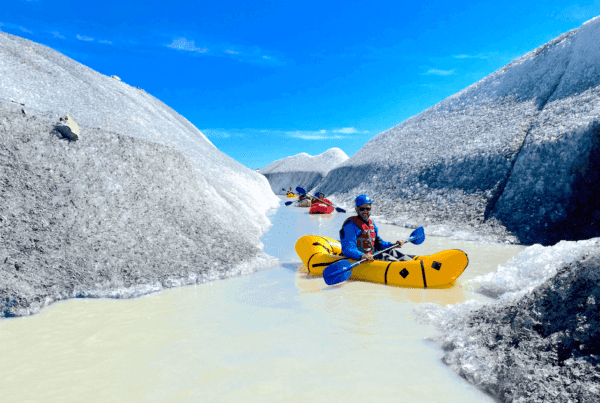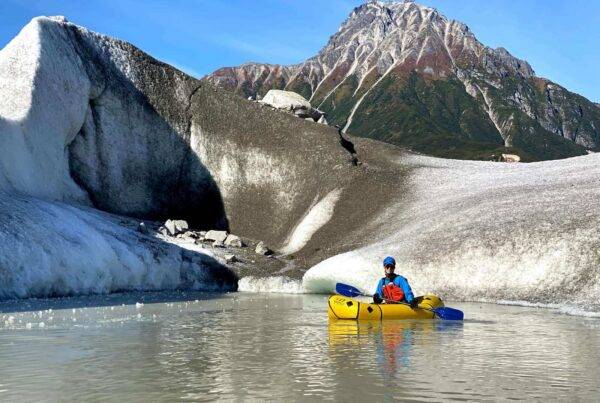You will encounter two different rating systems as you read about rivers and plan trips. The most common is the International Scale of River Difficulty, with its Class I-VI ratings. The other is a Class 1-10 system used on some western U.S. rivers, most commonly on the Grand Canyon stretch of the Colorado River. The 1-10 system roughly equates to Classes I-V on the International Scale, with 1-2 somewhat equivalent to Class I, 3-4 to Class II, 5-6 to Class III, 7-8 to Class IV and 9-10 to Class V.
Both of these rating systems offer an index of difficulty allowing you to determine whether you have the skills and equipment for a certain river or rapid. They are useful, as long as you recognize their limitations. Both systems are subjective, that is they are based on opinions, albeit opinions of experts. A number of factors can modify the ratings.

©Bill Parks
Region
Ratings are interpreted differently in different parts of the U.S. and the world. It’s quite common to hear comments like these from river runners – “Well, the guidebook calls this a Class IV run, but I think it’s only Class III.” Or, “In the (you name it) section of the country, they’d call this a Class V, but out here it would only qualify as a Class IV.” If you’re going boating in a new area, check with local sources.
Changing Conditions
A rating given to a river or rapid is a snapshot; it’s based on the informed opinion of persons who’ve been there, usually over multiple seasons and in many different flows. Still, it may not capture the difficulty of the river or rapid in all seasons and all flows. What may be a Class IV under normal conditions can be Class V in high spring flood. Wood, strainers and other obstacles can definitely up the difficulty level.
Location
Remoteness of location significantly affects difficulty rating. A stretch that would be Class III+ if it were along a road might well qualify for Class IV or IV+ if it’s in the backcountry, far from needed outside help.
Weather
Cold water and rainy conditions up the hazard level of any water. Taking a swim or even getting and staying wet, in these conditions, exposes boaters to the danger of hypothermia Cold Water Protection & Hypothermia.
The Unexpected
The night of June 10, 1965, heavy rains brought a wall of debris down Warm Springs Creek, a tributary of the Yampa River, in Colorado. It transformed what was just a riffle to what even today is rated as a Class IV rapid. A boatman in the first rafting party that went through the rapid on the morning of June 11th drowned.

©Josh Davis
Summary
The rating systems are invaluable for giving boaters a guide on what to expect when running a river system or rapid. Just remember, they are only guides. There is no hard and fast, ironclad way to determine if you are up to a certain rapid or river. Use good judgment, consult multiple sources and talk to others who’ve been there under similar conditions. When on the water, pay attention and stay alert for unexpected hazards and scout unfamiliar rapids.
The following version of the International Scale of River Difficulty is copied from the Safety Code of American Whitewater:
Class I Rapids
Fast moving water with riffles and small waves. Few obstructions, all obvious and easily missed with little training. Risk to swimmers is slight; self-rescue is easy.
Class II Rapids: Novice
Straightforward rapids with wide, clear channels which are evident without scouting. Occasional maneuvering may be required, but rocks and medium-sized waves are easily missed by trained paddlers. Swimmers are seldom injured and group assistance, while helpful, is seldom needed. Rapids that are at the upper end of this difficulty range are designated “Class II+”.
Class III: Intermediate
Rapids with moderate, irregular waves which may be difficult to avoid and which can swamp an open canoe. Complex maneuvers in fast current and good boat control in tight passages or around ledges are often required; large waves or strainers may be present but are easily avoided. Strong eddies and powerful current effects can be found, particularly on large-volume rivers. scouting is advisable for inexperienced parties. Injuries while swimming are rare; self-rescue is usually easy but group assistance may be required to avoid long swims. Rapids that are at the lower or upper end of this difficulty range are designated “Class III-” or “Class III+” respectively.
Class IV: Advanced
Intense, powerful but predictable rapids requiring precise boat handling in turbulent water. Depending on the character of the river, it may feature large, unavoidable waves and holes or constricted passages demanding fast maneuvers under pressure. A fast, reliable eddy turn may be needed to initiate maneuvers, scout rapids, or rest. Rapids may require “must” moves above dangerous hazards. Scouting may be necessary the first time down. Risk of injury to swimmers is moderate to high, and water conditions may make self-rescue difficult. Group assistance for rescue is often essential but requires practiced skills. A strong eskimo roll is highly recommended. Rapids that are at the lower or upper end of this difficulty range are designated “Class IV-” or “Class IV+” respectively.
Class 5: Expert
Extremely long, obstructed, or very violent rapids which expose a paddler to added risk. Drops may contain** large, unavoidable waves and holes or steep, congested chutes with complex, demanding routes. Rapids may continue for long distances between pools, demanding a high level of fitness. What eddies exist may be small, turbulent, or difficult to reach. At the high end of the scale, several of these factors may be combined. Scouting is recommended but may be difficult. Swims are dangerous, and rescue is often difficult even for experts. A very reliable eskimo roll, proper equipment, extensive experience, and practiced rescue skills are essential. Because of the large range of difficulty that exists beyond Class IV, Class 5 is an open-ended, multiple-level scale designated by class 5.0, 5.1, 5.2, etc… each of these levels is an order of magnitude more difficult than the last. Example: increasing difficulty from Class 5.0 to Class 5.1 is a similar order of magnitude as increasing from Class IV to Class 5.0.
Class VI: Extreme and Exploratory Rapids
These runs have almost never been attempted and often exemplify the extremes of difficulty, unpredictability and danger. The consequences of errors are very severe and rescue may be impossible. For teams of experts only, at favorable water levels, after close personal inspection and taking all precautions. After a Class VI rapids has been run many times, its rating may be changed to an apppropriate Class 5.x rating




